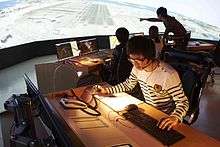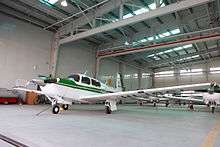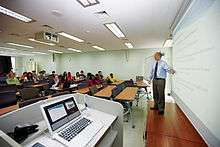Korea Aerospace University
| 한국항공대학교 | |
| Type | Private |
|---|---|
| Established | June 16th, 1952 |
| President | Dr. Kangwoong Lee |
Academic staff | 146[1] |
Administrative staff | 224 |
| Undergraduates | 4434 (as of 2012) |
| Postgraduates | 654 (as of 2012) |
| Location | Goyang, South Korea |
| Campus |
Main Campus at Goyang Flight Training Center at Goyang Flight Training Center at Jeju Flight Training Center at Uljin |
| Colors | Navy Cobalt Blue |
| Mascot | Peregrine Falcon, Pine Tree, Lilac |
| Website |
(English) (Korean) |
| Korea Aerospace University | |
| Hangul | 한국항공대학교 |
|---|---|
| Hanja | 韓國航空大學校 |
| Revised Romanization | Hanguk Hanggong Daehakgyo |
| McCune–Reischauer | Han'guk Hangkong Taehakkyo |
Korea Aerospace University (한국항공대학교 (韓國航空大學校) [Han’guk Hang-gong Dae-hak-gyo]) is a private university in Goyang City, Gyeonggi-do, South Korea. Established in 1952 as a national university, it was taken over by Jungseok Foundation established by Hanjin Group and transferred to a private university. The university — which encompasses most of the aerospace fields including Aerospace & Mechanical Engineering, Electronics, Telecommunications, Computer Engineering, Air Transportation and Logistics, Aeronautical Science & Flight Operation, and Air and Space Law — has been designated to take several national undertakings and collaborative research projects with prominent global corporations including GE, Airbus, PLANSEE since 2009.
Major research results have been observed in the realm of unmanned aerial vehicle (UAV), since the first autonomous formation flight of UAV and the first flight of solar powered UAV for 12 consecutive hours in Korea. ‘The 1st Hannuri’, the micro satellite (CubeSat), was developed and launched for the first time among Korean universities in 2006.
History

Beginnings (1950s~1960s)
Korea Aerospace University was established as a national school in June 16, 1952, when the Korean War was raged, under the Charter for Transport School which was granted by the Ministry of Transportation(which is now Ministry of Land, Transport and Maritime Affairs) to develop a civil aviation industry. Although the university primarily started as a two-year course school solely with three departments — Department of Flight Operation, Department of Aircraft Power, Department of Telecommunication Engineering — its status had been elevated by 1953.
After the War, the campus moved to Seoul in 1962, then to Goyang City, Gyeonggi-do in 1963, where it is today. School buildings were built (the Hangar, the Flight Training Center, and the Electronics & Telecommunication Building) and several institutes (the Central Library, the Maintenance Factory, the Wireless Lab, the Aviation Research Institute, the Training School for Aviation Tech) were opened.
Strengthened (1970s~1990s)
In 1979, the university was taken over by Jungseok Foundation, established by Hanjin Group, and it was transferred to a private university. Ever since the transformation, the university started to strengthen its inner and outer sides.
Through the modifications on quota and name, establishment of schools, departments, and graduate schools were finalized. Auxiliary organizations and institutes were reorganized (see “Centers and institutes”) to vitalize its inner strength.
For the latter, the Liberal Arts Building, Central Library, the Aviation Control Center, the Mechanical Engineering Building, and the Flight Operation Building were opened in 1970s; the Student’s Hall, the Science Building, the Mechanical Engineering Building, the Electronic Engineering Building were constructed in 1990s. Most of the structures were completed through this period.
Development (2000s~ )
Passing through the strengthening period, the university started to focus on ensuring its internal stability. From the early 2000s, structures were added and expanded. The Central Library, the Center for Technical Assiatance to Small and Medium-sized Industries, the KAU Aerospace Center/Museum, and the New Administrative Building were built. The Library and the Student’s Hall had a level extension.
The university changed its name from Hankuk Aviation University to Korea Aerospace University in 2007. It started to develop its competence by expanding international networks. After obtaining AABI (Aviation Accreditation Board International) qualification, for flight education, aviation management, air traffic management, and air transportation systems in 2007, MOUs (memoranda of understanding) and agreements with well-known organizations were concluded: MOUs with University of Southern California, Drexel University, Oregon State University; agreement for cooperation with Embry-Riddle Aeronautical University; joint development agreement with General Electric.
Reputation and research activities

Korea Aerospace University is the one and only university in Korea specialized in aviation and aerospace.
Reputation
- Selected as Education Capacity Enhancement Project for five years in a row, 2008~2012
- Accredited for ABEEK (Accreditation Board for Engineering Education of Korea), 2012
- Research funds per academic staff was ranked 6th, 2011
- Ranked 1st in the Management Evaluation for Private Universities, 2008
Research activities
- CDSRC (the Defense Specialized University Research Center), 2011~
- Maritime Transport Education Project, 2011~
- GSRC(Global Surveillance Research Center), 2010~
- Logistics Specialized Education Project, 2010~
- Seoul Accord Activation Center, 2010~
- Industrial Technology Development Project, 2010~
- WPM(World Premier Materials Project), 2010~
- The Korea Electric Vehicle and Transportation Safety Convergence System Research Consortium, 2010~
- Haneul Project (for Aerospace Engineers and Global Aviation Experts), 2009~
- Seven NSLs (National Space Laboratory) and three NRLs (National Research Laboratory), 2008~
Organization

Undergraduate
- College of Engineering
- School of Aerospace and Mechanical Engineering
- Mechanical Engineering
- Aerospace Engineering
- Aircraft System Engineering
- School of Electronics, Telecommunication & Computer Engineering
- Electronic and Avionics Engineering
- Information and Telecommunication Engineering
- Software Engineering
- Department of Materials Engineering
- School of Aerospace and Mechanical Engineering
- College of Aviation and Management
- School of Air Transportation and Logistics
- Air Transportation
- Logistics
- Air and Space Law
- Department of Aeronautical Science and Flight Operations
- School of Business
- Business Administration
- Global Aviation Management
- School of Air Transportation and Logistics
- School of Liberal Arts and Sciences
- Department of General Studies
- Department of English
Graduate
- Graduate School
- Master’s Course
- Aerospace & Mechanical Engineering
- Space Technology
- Materials Engineering
- Electronic Engineering
- Telecommunication & Information Engineering
- Computer Engineering
- Aviation Management
- Air Transport, Transportation and Logistics
- Business Administration
- English
- Air & space Law
- Doctor’s Course
- Aerospace & Mechanical Engineering
- Space Technology
- Materials Engineering
- Electronic Engineering
- Telecommunication & Information Engineering
- Computer Engineering
- Aviation Management
- Air Transport, Transportation and Logistics
- Business Administration
- English
- Master’s Course
- Graduate School of Aviation & Management
- Aviation Industry Group(Master)
- Techno-Management
- Air Transport, Transportation and Logistics
- Air & space Law
- Aviation Management
- Business Administration Group(Master)
- Business Administration
- Airline Management
- Tourism Management
- Advanced Management Program
- Aviation Industry Group(Master)
Laboratories

- School of Aerospace and Mechanical Engineering
- Micro & Nano Heat Transfer Laboratory
- Rocket Propulsion Laboratory
- Space System Research Laboratory
- Welding Laboratory
- Fluid Power Control Laboratory
- Applied Aerodynamic Laboratory
- Spacecraft Control Laboratory
- System Design Optimization Laboratory
- School of Electronics, Telecommunication & Computer Engineering
- Logic Circuit Laboratory
- Data Mining Laboratory
- Radar Signal Processing Laboratory
- Parallel & Distributed Processing Laboratory
- Applied Network Research Laboratory
- Navigation & Information Systems Laboratory
- Mobile Communication Laboratory
- NGN Laboratory
- RF Circuit Laboratory
- Silicon Graphics Laboratory
- School of Air Transport, Transportation and Logistics
- Ubiquitous Technology Application Research Center
Centers and institutes
- Global Aviation Training Institute (GATI)
- Institute of International Culture and Education
- KAU Aerospace Museum
- Central Library
- R&D Residence Complex
- Computing Center
- Air Traffic Control Station
- University Newspaper
- University Broadcasting Station
- University Press Office
- Research Institute of Aerospace Engineering and Technology
- Aerospace and Aviation Electronics Research Center
- Institute for Community Research
- Institute for Aircraft Safety and System Management
- Institute for Aviation Industry, Policy and Law
- Student Counseling Center
- Institute for Business Studies
- Institute for Humanities and Natural Science
- Center for Technical Assistance to Small and Medium-sized Industries
- IT Research Center
- Institute of Transportation and Logistics
- Research Center for Internet Information Retrieval
- Advanced Broadcasting Media Technology Research Center
- Ubiquitous Technology Application Research Center (UTAC)
- KAU Research Center for Robotics
- Information Protection Research
- Innovating Engineering Education Center
- Innovating Aviation and Management Education Center
- Center for Teaching and Learning
Remarkable Facilities

KAU Aerospace Museum
Korea Aerospace University established the KAU Aerospace Museum in pursuance of elevating the understanding on aviation and aerospace for the public on August 2004. With the area of 780m2, the museum exhibits more than 800 aviation and aerospace parts. It is structured with ‘Aerospace Zone’ introducing the history of aerospace, ‘Flight Simulator’, ‘Virtual Experience’, ‘Experience Zone’ displaying various plastic airplane, ‘Future of Aerospace Zone’ exhibiting the history and principle of rocket and satellite. KAU Aerospace Museum also earned the first accreditation from the FAI(Fédération Aéronautique Internationale) in Korea and was selected for receiving a benefit from ‘Boeing GCC Fund’.
Flight Training Center
Flight Training Center (FTC) at Korea Aerospace University, one of the subsidiaries of GATI, was founded to produce global-standard pilots for airlines and the military. The FTC provides a civil aviation pilot training program entrusted to KAU by Korean Air. For the development of general aviation, the FTC also has a flight training course for members of the public who want to learn how to fly.
FTC-Susaek
On the KAU campus, FTC-Susaek operates a private pilot course and instrument rating course, both certified by Korea’s Ministry of Land, Transport and Maritime Affairs. FTC-Susaek operates an academic training course for APP ab-initio cadets and Korean Air (KAL) pilots, as well as a flight training course for the public.
FTC-Jungseok
FTC-Jungseok operates a jet transition course for Korean Air (KAL) pilots. FTC-Jungseok operates four CE-560s and two CE-525 aircraft, as well as CE-525 and CTN-II simulators for the course.
FTC-Uljin
At Uljin Airport on South Korean’s eastern coast, FTC-Uljin operates a pilot training course certified by Korea’s Ministry of Land, Transport and Maritime Affairs. The airline pilot training program adheres to stringent global standards. FTC-Uljin operates seven brand new single engine aircraft with glass cockpits, as well as a multi-engine aircraft and two FTDs used for flight training.
| Course | Qualifications | Training Period | Career Path |
|---|---|---|---|
| APP (Airline Pilot Program) |
≤ Bachelor’s Degree | 3 yrs | Airline pilot |
| Uljin (Uljin Pilot Program) |
anyone | 1 yr | Airline pilot |
| MPP (Military Pilot Program) |
KAU students majoring Flight Operations | 2 yrs | Military pilot |
| CPC (Commercial Pilot Course) |
KAU students majoring Flight Operations | 1 yr | Airline pilot |
| Advanced (Jet Transition Course) |
KAL employee | Over 3 mth | KAL pilot |
| When to Apply | How to apply | Qualification |
|---|---|---|
| 4 times a year | Online application via the FTC website | ≤ Bachelor’s Degree |
International Programs

Korean Language Program
The Korean Language Education Center (KLEC), established in July 2006, founded the Korean Language Program to meet the growing demand from foreign students for qualified, innovative, and progressive Korean language training. The program implements a proven program that has been nationally recognized as the most effective method of language acquisition to date. The curriculum is supported with supplemental materials such as exercise books.
Study abroad
Korea Aerospace University provides study abroad programs for students to gain overseas experiences. The programs are NASA and Boeing Fieldtrip, Research Internship at University of Southern California (USC), Work & Travel Program at University of North Dakota (UND), visiting overseas firms by self-designed plan, and others.
Partner universities (by continent)
- North America
- Drexel University, U.S.
- Eastern Kentucky University, U.S.
- Embry-Riddle Aeronautical University, U.S.
- Florida Institute of Technology, U.S.
- Green Mountain College, U.S.
- Long Island University, U.S.
- McGill University, Canada
- Marquette University, U.S.
- Michigan Technological University, U.S.
- Northrop-Rice Aeronautical University, U.S.
- Ohio State University, U.S.
- Ohio University, Avionics Engineering Center, U.S.
- Oregon State University, U.S.
- Rose-Hulman Institute of Technology, U.S.
- Saint Louis University Parks College, U.S.
- University of Arizona, U.S.
- University of Florida, U.S.
- University of Nebraska Kearney, U.S.
- University of North Dakota, U.S.
- University of Southern California, U.S.
- Virginia Polytechnic Institute and State University, U.S.
- Asia
- Fudan University, China
- Beijing University of Aeronautics & Astronautics, China
- Civil Aviation University of China, China
- Nanchang Institute of Aeronautical Technology, China
- Nanjing University of Aeronautics & Astronautics, China
- Qiqihar University, China
- Shanghai Jiao Tong University, China
- Shenyang Institute of Aeronautical Engineering, China
- Yanbian University of Science and Technology, China
- The Hong Kong Polytechnic University, Hong Kong
- India Hindustan University, India
- Vellore Institute of Technology, India
- Japan Chuo Gakuin University, Japan
- Japan Aviation Academy, Japan
- Kyoto University, Japan
- National Institute of Information and Communications Technology, Japan
- University of Malaya, Malaysia
- Ulaanbaatar College, Mongol
- Myanmar Aerospace Engineering University, Myanmar
- University of Computer Studies, Yangon
- Angeles University, Philippines
- Bulacan State University, Philippines
- Saint Paul University, Philippines
- University of Cebu, Philippines
- University of Reginal Carmeli, Philippines
- University of Saint Tomas, Philippines
- University of Bangkok, Thailand
- Tashkent State Technical University, Uzbekistan
- Vietnam National University, Hanoi, Vietnam
- Europe
- Cranfield University, U.K
- Imperial College of Science, Tech and Medicine, U.K
- University College London, U.K
- Brunel University, U.K
- Russia Academy of Civil Aviation, Russia
- Moscow State Aviation Institute, Russia
- University of Castilla-La Mancha, Spain
- International Space University, France
- Leiden University, Netherlands
- National Aviation University, Ukraine
- Oceania
- Central Queensland University, Australia
- University of Sydney, Australia
- Massey University, New Zealand
Notable alumni
- Jongrok Yoon (윤종록): former vice minister of Ministry of Science, ICT and Future Planning
- Cheolsoo Bae (배철수): radio disc jockey and former vocalist and guitarist of a hard rock band, Song Gol Mae
- Youngkeun Chang (장영근): Professor, School of Aerospace and Mechanical Engineering, Korea Aerospace University
- Sooin Hong (홍수인): captain, Korean Air, the first woman captain of civil aircraft in Korea
- Chul Hwang(황철): head of flight operations, Korean Air
- Manhui Jang (장만희): vice president, Air Navigation Commission at ICAO
- Seokjin Kang (강석진): professor, United States Naval Academy
- Changyong Kim (김창용): vice president of Samsung Electronics at DMC
- DongSeong Kim(김동성): professor, University of Canterbury, New Zealand
- Jungsik Kim (김정식): president, University-Industry Foundation at Soonchunhyang University
- Kyungjin Kim (김경진): president, EMC Korea
- Woojae Kim (김우재): president, World Federation of Overseas Korean Traders Associations
- Hwasuk Oh (오화석): professor, School of Aerospace and Mechanical Engineering, Korea Aerospace University
- Kwanghyun Seo (서광현): director, Korean Agency for Technology and Standards
- Jongwoon Shin (신종운): vice president, Hyundai-Kia Motor Group
References
External links
- Korea Aerospace University (English)
- Korea Aerospace University (Korean)
Coordinates: 37°35′58″N 126°51′54″E / 37.5994°N 126.8651°E